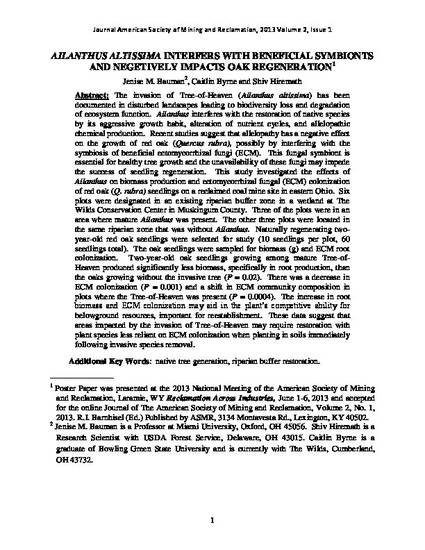
- Native tree generation,
- Riparian buffer restoration
The invasion of Tree-of-Heaven (Ailanthus altissima) has been documented in disturbed landscapes leading to biodiversity loss and degradation of ecosystem function. Ailanthus interferes with the restoration of native species by its aggressive growth habit, alteration of nutrient cycles, and allelopathic chemical production. Recent studies suggest that allelopathy has a negative effect on the growth of red oak (Quercus rubra), possibly by interfering with the symbiosis of beneficial ectomycorrhizal fungi (ECM). This fungal symbiont is essential for healthy tree growth and the unavailability of these fungi may impede the success of seedling regeneration. This study investigated the effects of Ailanthus on biomass production and ectomycorrhizal fungal (ECM) colonization of red oak (Q. rubra) seedlings on a reclaimed coal mine site in eastern Ohio. Six plots were designated in an existing riparian buffer zone in a wetland at The Wilds Conservation Center in Muskingum County. Three of the plots were in an area where mature Ailanthus was present. The other three plots were located in the same riparian zone that was without Ailanthus. Naturally regenerating two- year-old red oak seedlings were selected for study (10 seedlings per plot, 60 seedlings total). The oak seedlings were sampled for biomass (g) and ECM root colonization. Two-year-old oak seedlings growing among mature Tree-of- Heaven produced significantly less biomass, specifically in root production, than the oaks growing without the invasive tree (P = 0.02). There was a decrease in ECM colonization (P = 0.001) and a shift in ECM community composition in plots where the Tree-of-Heaven was present (P = 0.0004). The increase in root biomass and ECM colonization may aid in the plant’s competitive ability for belowground resources, important for reestablishment. These data suggest that areas impacted by the invasion of Tree-of-Heaven may require restoration with plant species less reliant on ECM colonization when planting in soils immediately following invasive species removal.
Available at: http://works.bepress.com/jenise_bauman/13/
